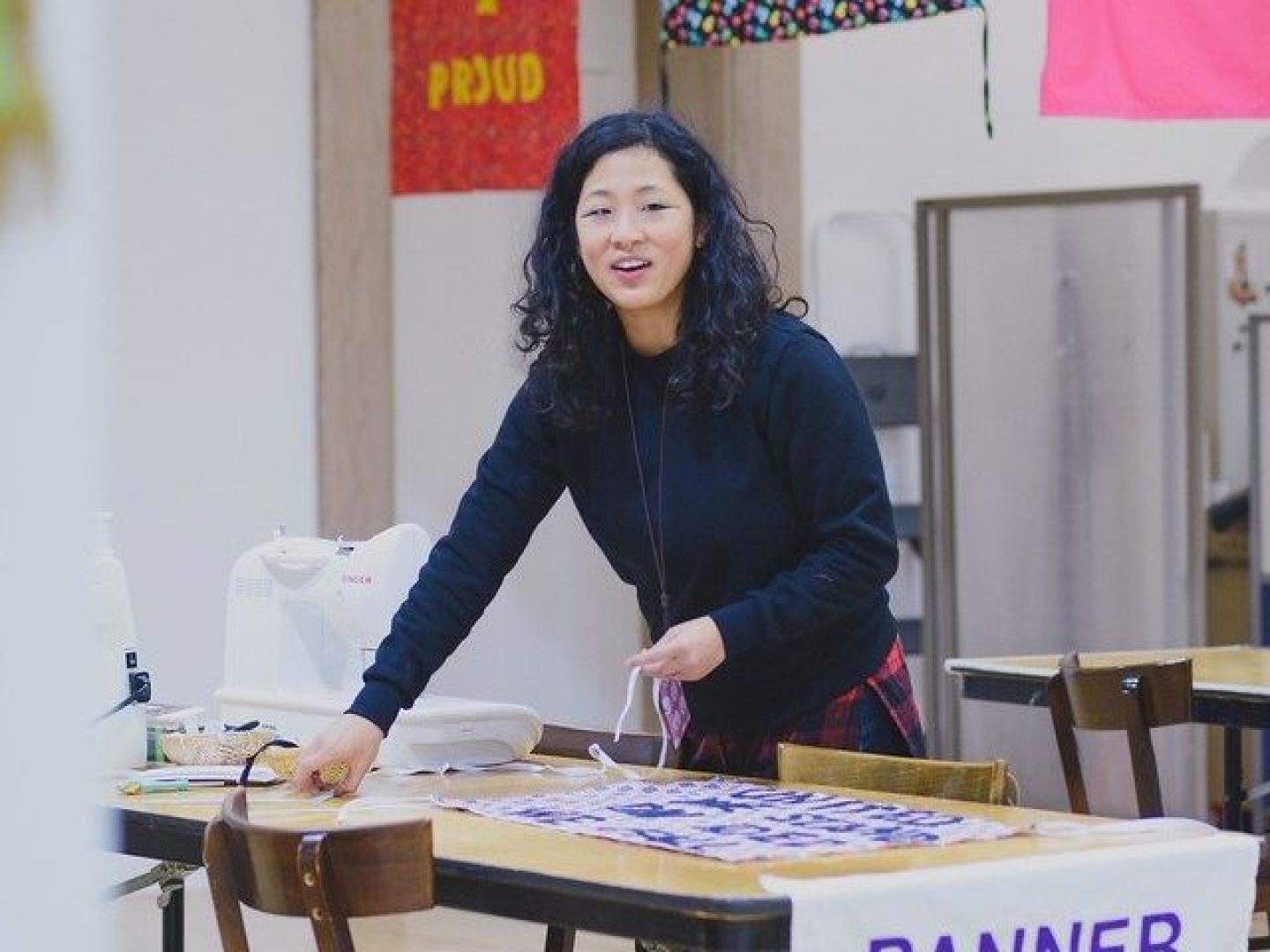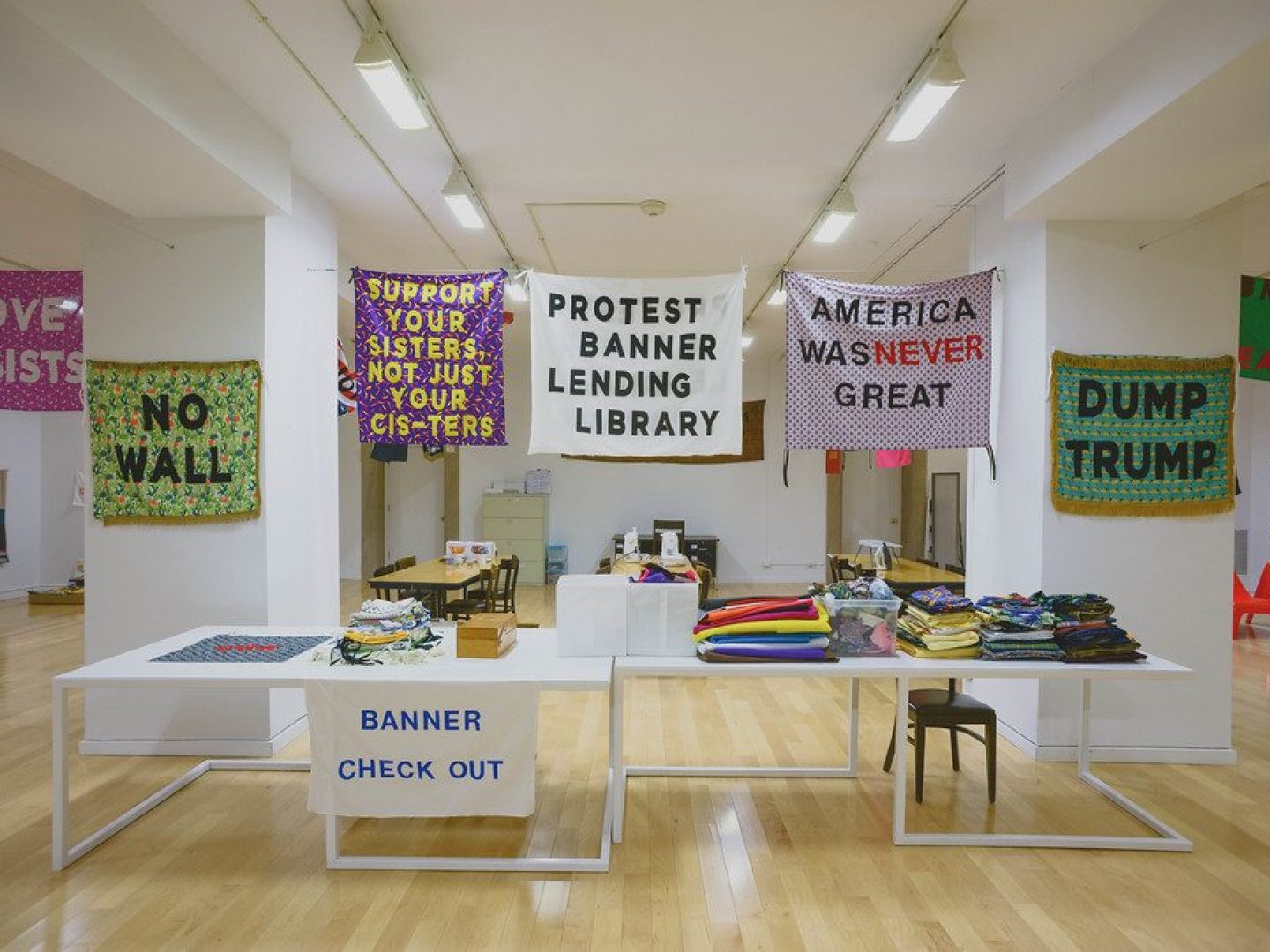

Aram Han Sifuentes is an American artist and educator who’s work involves examining the roles of citizenship and immigration through crafts and needlework. We asked her to explain a little about her personal influences and her most recent project: The Protest Banner Lending Library.
I learned how to sew when I was six years old. My family had moved to the United States from South Korea when I was five years old. My parents took on work at a dry cleaners and my mom became a seamstress.
My mom taught me how to sew so I could sew alongside her while she would do her work, which she still does today. As an artist I use the needle and thread to mine from my experiences as an immigrant to address issues of labor and identity politics. I try to unpack complex labor and immigrant histories by engaging with people through long term projects utilizing varied social practices. During the 2016 U.S. Presidential Elections I created a project called The Official Unofficial Voting Station: Voting for All Who Legally Can’t
at the Jane Addams Hull House Museum in Chicago, IL where I collaborated with artists, activists, organizations (Roberto Sifuentes, Sadie Rock, Marianne Sadowski, Brandon Bullard, Cecilia Aguilar Castillo and Erick Fernández Saldaña, Maritea Daehlin, Lilah Thompson, Veronica Casado Hernandez, Hannah Hiaasen, Yvette Mayorga, Mara Baldwin, Lise Haller Baggesen, Latino Advocacy) in order to create 25 different voting stations all over the United States and Mexico open to all but particularly for the disenfranchised.


In these voting stations Hilary Clinton won by a clear landslide (Clinton got 1246 votes and Trump got 148 votes).
But at the official election on November 8th, 2016 Trump won the U.S. Presidential Elections. Personally, I was devastated by the elections, as many were. Coming from a place of great anxiety and disorientation, I found the only thing I could do was make. I started to make protest banners in my apartment.
Needing to feel a sense of community, I started to put open calls on Facebook inviting all who wanted to learn how to make their own banners to come over to my apartment to make them with me. Quickly more people were interested than my place could accommodate, and at the same time arts organizations were reaching out to me to do Protest Banner Making Workshops for the public. The project quickly grew and from November 2016 to May 2017
Protest Banner Making Workshops took place at the Comfort Station in Chicago, IL; Smart Museum in Chicago, IL; Jane Addams Hull-House Museum in partnership with Gallery 400 (with Lisa Vinebaum) in Chicago, IL; Whitney Museum of American Art (with Cauleen Smith) in NYC, New York; Art Institute of Chicago in Chicago, IL. The Protest Banner Lending Library (now a team of four with Veronica Casado Hernandez, Ishita Dharap, Tabitha Anne Kunkes and myself)
"...as a non citizen and a new mother, I do not always feel safe going to protests"
took on a public residency at the Chicago Cultural Center from February to May 2017 where we were open to the public for 24 hours a week where the public could walk in anytime to make banners and check them out to use.
Making banners is a way for me to resist what is happening in the United States and in the world. It is a way to put my voice out there and not stay silent. However, as a non citizen and a new mother, I do not always feel safe going to protests.
This is the reason that this project turned into a Protest Banner Lending Library, where people are invited to make banners and for those who cannot easily go to protests for whatever reason can donate their made banners to this library where others can check out to use. The Protest Banner Lending Library is a space for people to gain skills to learn to make their own banners, a communal sewing space where we support each other’s voices,
and a place where people can check out handmade banners to use. In this way the words and these banners have a growing history. They are made by someone, used in a protest, returned to the library, and then taken by someone else to a different protest. The banners carry the histories of the hands that made and hold them, and the places they have and will travel.


Over 500 banners have been made in the workshops and we currently have over 125 banners in the library. Most of the banners have been checked out multiple times for various uses. Some of the uses include: Women’s March in Chicago and in Washington D.C., Trans-liberation March in Chicago, IL, Free Street Theater HQ Ensemble’s stage set, Native Nations Rise March in Washington, D.C., Science March in Chicago and in Washington D.C.
Banner donations have also been made from people all over the United States who have heard of the project and shipped their banners to be circulated in the library. The generosity and activation of the public continues to fuel the project.
Textiles have a long history of being used in protests and political acts, notably the extensive use of banners in the Women’s Suffrage Movements.
Making a banner out of textiles as opposed to paper speaks to transportability and durability. One can fold up a textile banner and carry it around easily. I’m surprised whenever I go out and someone pulls one of the Protest Banner Lending Library banners out of their purse or backpack. In the current political climate where protests are happening on a weekly if not daily basis, this is an important factor to consider. Textile banners also speaks to time.
"The banners carry the histories of the hands that made and hold them, and the places they have and will travel."
Our banners are made by using fusible web and each take about two hours to complete. As opposed to paper or cardboard protest sign which usually only lasts one or two uses, a textile banner is more durable and can live through multiple uses.
Again this resonates with the current political climate in the United States where politics demand an endured resistance. Currently the project is in great demand. We are continually facilitating workshops and lending out and receiving banners.
Ironically the goal of the project is for it own expiration, that we will shape a world where protests and these banners will no longer be of use.
Aram Han Sifuentes
